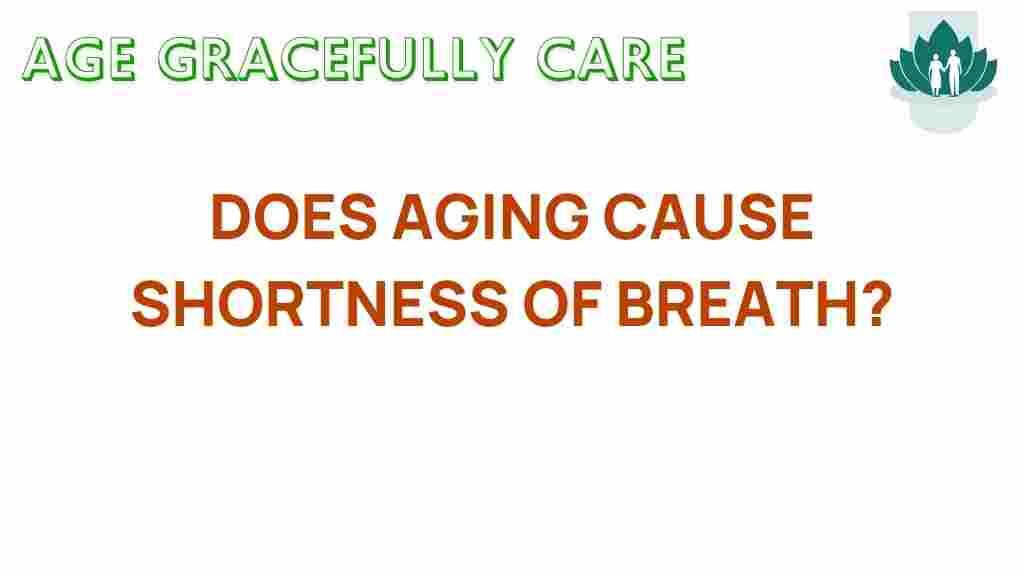Unraveling the Mystery: Does Aging Lead to Shortness of Breath?
As we age, our bodies undergo various changes that can affect our overall health and well-being. One common concern among seniors is the experience of shortness of breath. This article aims to explore the relationship between aging and breathing difficulties, discussing the implications for respiratory health, lung function, and senior wellness. We will also delve into age-related changes that can contribute to these health concerns and provide practical tips for managing them.
The Link Between Aging and Shortness of Breath
Shortness of breath, or dyspnea, can manifest in various situations, from mild exertion to rest. Understanding the underlying reasons for this phenomenon is crucial, especially for the elderly. As we age, several physiological changes can impact our respiratory health, leading to potential breathing difficulties.
- Decreased Lung Capacity: The lungs naturally lose some elasticity with age, leading to reduced lung capacity. This can make it more difficult to breathe deeply, especially during physical activity.
- Weakening Muscles: The muscles involved in breathing, including the diaphragm and intercostal muscles, may weaken over time. This can result in less effective breathing.
- Increased Airway Resistance: Age-related changes in the airways can lead to increased resistance, making it harder to move air in and out of the lungs.
- Chronic Health Conditions: Older adults are more likely to have chronic conditions, such as asthma or COPD (chronic obstructive pulmonary disease), which can exacerbate shortness of breath.
Understanding Age-Related Changes in Respiratory Health
As we age, our bodies undergo various transformations that can affect our lung function and overall respiratory health. Here are some key changes to consider:
- Reduced Alveolar Surface Area: The tiny air sacs in the lungs, called alveoli, may decrease in number and size, reducing the surface area available for gas exchange.
- Stiffening of Lung Tissue: The lung tissues can become stiffer, making it harder for the lungs to expand and contract during breathing.
- Decreased Immune Function: The immune system tends to weaken with age, increasing the risk of respiratory infections that can lead to breathing difficulties.
- Changes in Breathing Patterns: Older adults may develop irregular breathing patterns, which can contribute to feelings of breathlessness.
Health Concerns Related to Shortness of Breath in Seniors
Shortness of breath in older adults can be concerning, as it may indicate underlying health issues. Here are some health concerns associated with this symptom:
- Cardiovascular Diseases: Conditions like heart failure and coronary artery disease can lead to shortness of breath, particularly during exertion.
- Respiratory Diseases: Diseases such as asthma, pneumonia, and COPD are common among seniors and can significantly impact lung function.
- Obesity: Excess weight can contribute to breathing difficulties, particularly in older adults.
- Anxiety and Depression: Mental health issues can exacerbate feelings of breathlessness and should not be overlooked.
Managing Shortness of Breath: A Step-by-Step Process
Managing shortness of breath involves a combination of lifestyle adjustments, medical interventions, and awareness of triggers. Here’s a structured approach to addressing this issue:
1. Recognize Triggers
Identifying situations or activities that trigger shortness of breath is essential. Common triggers may include:
- Physical exertion (e.g., climbing stairs)
- Environmental factors (e.g., smoke, allergens)
- Emotional stress
2. Practice Breathing Techniques
Learning and practicing effective breathing techniques can help manage shortness of breath.
- Pursed-Lip Breathing: Inhale through the nose and exhale slowly through pursed lips. This helps keep airways open.
- Diaphragmatic Breathing: Focus on using the diaphragm rather than the chest for breathing to improve lung efficiency.
3. Maintain Physical Activity
While it might seem counterintuitive, regular physical activity can improve lung function and overall endurance. Consider the following:
- Engage in low-impact exercises such as walking, swimming, or yoga.
- Incorporate strength training to enhance muscle strength, which supports better breathing.
4. Monitor Environmental Factors
Keep an eye on your environment. Avoid exposure to pollutants, allergens, and other irritants that may exacerbate breathing difficulties.
5. Consult Healthcare Providers
If shortness of breath persists or worsens, it’s crucial to consult a healthcare provider. They may recommend:
- Pulmonary Function Tests: These tests measure how well your lungs are functioning.
- Medications: Inhalers or other medications may be prescribed to manage respiratory conditions.
- Rehabilitation Programs: Pulmonary rehabilitation can help improve lung function and quality of life.
6. Lifestyle Changes
Adopting a healthier lifestyle can have a significant impact on respiratory health:
- Quit Smoking: If you smoke, seek help to quit. Smoking is a major contributor to respiratory diseases.
- Eat a Balanced Diet: A diet rich in fruits, vegetables, and whole grains can promote overall health.
- Stay Hydrated: Adequate hydration helps keep the mucous membranes in the airways moist.
Troubleshooting Tips for Breathing Difficulties
For seniors experiencing shortness of breath, the following troubleshooting tips may provide relief:
- Stay Calm: Anxiety can worsen feelings of breathlessness. Practice relaxation techniques to help calm your mind.
- Use a Fan: A gentle breeze from a fan can make breathing feel easier.
- Positioning: Adjusting your body position can help. Sit upright or lean forward slightly to ease breathing.
- Limit Activities: Pace yourself and avoid overexertion, especially during activities that increase heart rate.
Conclusion
In conclusion, while aging can contribute to shortness of breath and other breathing difficulties, understanding the underlying factors and making appropriate lifestyle adjustments can significantly improve respiratory health. By recognizing triggers, practicing breathing techniques, maintaining an active lifestyle, and consulting healthcare professionals, seniors can enhance their lung function and overall senior wellness. It is essential for caregivers and family members to be aware of these issues, as they can play a vital role in elderly care.
For more information on managing respiratory health in seniors, visit this resource. If you are interested in further reading on age-related changes and their impact on health, check out this article.
This article is in the category Health and created by AgeGracefullyCare Team
